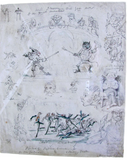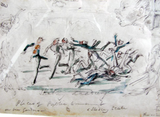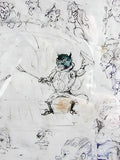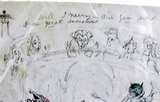A Fine And Rare Study Drawing By George Cruikshank. Finely Detailed Sketches He "Doodled" Before He Implemented The Figures Into A Finished Piece. Most Studies, Like This Example, Rarely Survive. This Is Approximately 7 1/4" Wide x 9" High.
Sold By Parke-Bernet Galleries - From The Eldridge R. Johnson Collection - Part V October 29, 1946.
Sold By Parke-Bernet Galleries - From The Eldridge R. Johnson Collection - Part V October 29, 1946.
From Wikipedia:
Sociopolitical caricatures and illustrations
Cruikshank's early career was renowned for his social caricatures of English life for popular publications.
He achieved early success collaborating with William Hone in his political satire The Political House That Jack Built (1819).
The New Union Club dinner with black guests
In the same year he produced the remarkable anti-abolitionist New Union Club. It satirised a dinner party organised by abolitionists with black guests.
His first major work was Pierce Egan's Life in London (1821) in which the characters Tom and Jerry, two 'men about town' visit various London locations and taverns to enjoy themselves and carouse. This was followed by The Comic Almanack (1835–1853) and Omnibus (1842).
Old Bumblehead the 18th trying on Napoleon Boots 1823
He gained notoriety with his political prints that attacked the royal family and leading politicians. In 1820 he received a royal bribe of £100 for a pledge "not to caricature His Majesty" (George IV of the United Kingdom) "in any immoral situation". His work included a personification of England named John Bull who was developed from about 1790 in conjunction with other British satirical artists such as James Gillray, and Thomas Rowlandson.
Cruikshank replaced one of his major influences, James Gillray, as England's most popular satirist. For a generation he delineated Tories, Whigs and Radicals impartially. Satirical material came to him from every public event – wars abroad, the enemies of Britain (he was highly patriotic), the frolic, among other qualities, such as the weird and terrible, in which he excelled. His hostility to enemies of Britain and a crude racism is evident in his illustrations commissioned to accompany William Maxwell's History of the Irish rebellion in 1798 (1845) where his lurid depictions of incidents in the rebellion were characterised by the simian-like portrayal of Irish rebels. Among the other racially engaged works of Cruikshank there were caricatures about the "legal barbarities" of the Chinese, the subject given by his friend, Dr. W. Gourley, a participant in the ideological battle around the Arrow War, 1856–60.
Charles Dickens
For Charles Dickens, Cruikshank illustrated Sketches by Boz (1836), The Mudfog Papers (1837–38) and Oliver Twist (1838). Cruikshank even acted in Dickens's amateur theatrical company.
On 30 December 1871 Cruikshank published a letter in The Times which claimed credit for much of the plot of Oliver Twist. The letter launched a fierce controversy around who created the work. Cruikshank was not the first Dickens illustrator to make such a claim. Robert Seymour who illustrated the Pickwick Papers suggested that the idea for that novel was originally his; however, in his preface to the 1867 edition, Dickens strenuously denied any specific input.
The friendship between Cruikshank and Dickens soured further when Cruikshank became a fanatical teetotaler in opposition to Dickens's views of moderation.
In Somerset Maugham's short story "Miss King", Cruickshank's influence is referenced: "She wore a large white cotton nightcap (on entering Ashenden has noticed the brown wig on a stand on the dressing-table) tied under the chin and a white voluminous nightdress that came high up in the neck. Nightcap and nightdress belonged to a past age and reminded you of Cruickshank's illustrations to the novels of Charles Dickens."
Sociopolitical caricatures and illustrations
Cruikshank's early career was renowned for his social caricatures of English life for popular publications.
He achieved early success collaborating with William Hone in his political satire The Political House That Jack Built (1819).
The New Union Club dinner with black guests
In the same year he produced the remarkable anti-abolitionist New Union Club. It satirised a dinner party organised by abolitionists with black guests.
His first major work was Pierce Egan's Life in London (1821) in which the characters Tom and Jerry, two 'men about town' visit various London locations and taverns to enjoy themselves and carouse. This was followed by The Comic Almanack (1835–1853) and Omnibus (1842).
Old Bumblehead the 18th trying on Napoleon Boots 1823
He gained notoriety with his political prints that attacked the royal family and leading politicians. In 1820 he received a royal bribe of £100 for a pledge "not to caricature His Majesty" (George IV of the United Kingdom) "in any immoral situation". His work included a personification of England named John Bull who was developed from about 1790 in conjunction with other British satirical artists such as James Gillray, and Thomas Rowlandson.
Cruikshank replaced one of his major influences, James Gillray, as England's most popular satirist. For a generation he delineated Tories, Whigs and Radicals impartially. Satirical material came to him from every public event – wars abroad, the enemies of Britain (he was highly patriotic), the frolic, among other qualities, such as the weird and terrible, in which he excelled. His hostility to enemies of Britain and a crude racism is evident in his illustrations commissioned to accompany William Maxwell's History of the Irish rebellion in 1798 (1845) where his lurid depictions of incidents in the rebellion were characterised by the simian-like portrayal of Irish rebels. Among the other racially engaged works of Cruikshank there were caricatures about the "legal barbarities" of the Chinese, the subject given by his friend, Dr. W. Gourley, a participant in the ideological battle around the Arrow War, 1856–60.
Charles Dickens
For Charles Dickens, Cruikshank illustrated Sketches by Boz (1836), The Mudfog Papers (1837–38) and Oliver Twist (1838). Cruikshank even acted in Dickens's amateur theatrical company.
On 30 December 1871 Cruikshank published a letter in The Times which claimed credit for much of the plot of Oliver Twist. The letter launched a fierce controversy around who created the work. Cruikshank was not the first Dickens illustrator to make such a claim. Robert Seymour who illustrated the Pickwick Papers suggested that the idea for that novel was originally his; however, in his preface to the 1867 edition, Dickens strenuously denied any specific input.
The friendship between Cruikshank and Dickens soured further when Cruikshank became a fanatical teetotaler in opposition to Dickens's views of moderation.
In Somerset Maugham's short story "Miss King", Cruickshank's influence is referenced: "She wore a large white cotton nightcap (on entering Ashenden has noticed the brown wig on a stand on the dressing-table) tied under the chin and a white voluminous nightdress that came high up in the neck. Nightcap and nightdress belonged to a past age and reminded you of Cruickshank's illustrations to the novels of Charles Dickens."











